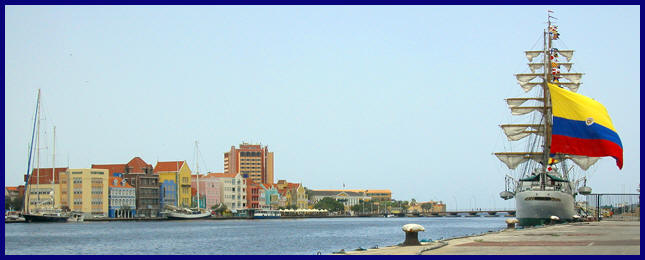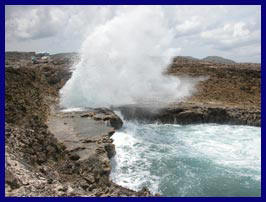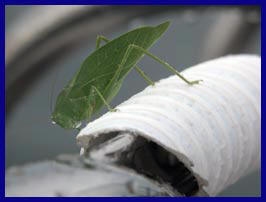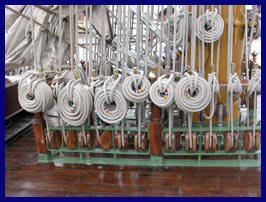
| Curaçao, the second of the ABC's (Aruba being the third) and only 38 miles downwind from Bonaire, but a different world. Whereas Bonaire exists almost solely as a tourist destination, Curaçao is a real place with industry, infrastructure and a fine deep water port. True, the industry is heavily focused on the sprawling oil refinery that seems to dominate much of the capital Willemstad, but it is industry nonetheless. Fortunately, the oil storage tanks and flares are not visible from the central shopping area, which is what most tourists see. |  |
| Curaçao also has a large and well
protected anchorage at Spanish Water where there are often eighty or more
cruising (and no longer cruising) yachts at anchor. In an effort to keep
entrance channels and recreational areas free a number of designated anchoring
zones have been established. And that led to our first experience of Curaçao
officialdom.
There is no pilot or cruising guide for Curaçao, so before we left Bonaire we had a quick search of the internet to see if we could discover the location of these anchoring zones. No luck. We found references to them, but not the locations, even on the Curaçao Harbour Master's web site. There it reinforced that anchoring was only permitted in the recognised zones, but remained silent on where they actually were. Now none of this was really a problem. When we arrived, the zones would almost certainly be self evident - they'd be the areas where the yachts where anchored - ¿No? But this had now become something of a mission, and the Harbour Master's site had a FAQ section. I checked it out. It was empty, not a single FAQ, but an invitation to email any question you had to the Harbour Master. So I did - "I've been looking for the location of the anchoring zones, but I can't find them, we want to be sure to anchor in the right place, can you tell me their coordinates?" I received a reply almost immediately, and from the Harbour Master himself - "It is not necessary for us to publish all of this information. When you arrive you must visit Customs and Immigration, then come to the Harbour Master's office and we will tell you then where you may anchor." Well, thanks for the help. And where, pray, should we anchor before you tell us where we can anchor? Was the Harbour Master's name Kafka? I checked, it wasn't. (For the record it was Ramon Frankel.) The next day someone from the Harbour Master's office did actually send us a small chart of the anchorage and once we arrived it was, as predicted, pretty obvious |
|
|
|
|
| Spanish Water at Curacao is well set up
for cruisers with a daily cruisers radio net, dinghy dock, free shopping
buses, wifi, happy hours (with added mosquitoes), etc, etc. Additionally there is good spares
availability and what isn't available locally can be shipped in quickly from
Miami (of course at a price). Strangely though, skilled workers of all types,
mechanics, riggers, welders etc all seem in short supply - perhaps the oil
industry absorbs all available technical skill. That said, Curaçao is by far
the best place to get things done for many hundred miles. In spite of what at first seemed the many attractions, we found Curaçao a strangely unwelcoming place. Hard to put our fingers on exactly why this is, but many other yachties we've met have said the same. It's certainly true that the happy hours and social events seem to split more noticeably along nationalistic, or more accurately linguistic, lines than in any other place we've been before. This certainly reduces the sense of community which normally exists in any seasonal anchorage, though we're not sure whether it is cause or effect. There's also the fact that Curaçao is, much more than most other places, a kind of floating transit camp. For most boats Panama beckons and they are only in Curaçao waiting for the end of the hurricane season. Who knows? Whatever the reason Curaçao is not number one on our list of return destinations. |
|
 |
So, why were we in Curaçao? Well,
it was on the way to Panama. We weren't sure we were going to Panama, but
we had a vague plan of spending Christmas in Cartegena. It was a vague
plan though. More important was the need to replenish our dwindling
stock of spares. But most important of all was to find someone who could,
once and for all, fix our problem generator! And his name was Bertie. Well, it's a long, sad and expensive story. We've lost count of the number of times we lifted the genset out of the boat and then reinstalled it. We became masters at it. Barry pulling, Torres pushing, Lindy winching and finally swinging it out on the boom to drop it into Bertie's waiting boat. We've also lost track of how much money we spent, and how many parts we shipped in (culminating in a replacement engine). Finally though, and I know it's unlucky to mention it, but apart from a small, yet to be fixed, oil leak (it is very hard to motivate ourselves to lift the bloody thing again!) it does now seem to be back to it's old reliable self. |
| One other major project whilst we were there was to modify our targa arch to accept a second wind generator and additional solar panels. Lindy also took the opportunity to complete our cockpit enclosure so that we can be protected from wind, rain and sun. All of which together amounts to a virtual guarantee that the Caribbean will be uncharacteristically windless, dry and overcast for the foreseeable future....... | |
| Our time in Curaçao though was anything other than windless and dry. We sat in Spanish Waters as Hurricane Tomás passed just north of us. Not that much wind (35knots) but the rain was spectacular. Even two rainy seasons in Brasil hadn't prepared us for rain like this. We don't know exactly how much fell that first night, but the buckets we'd left on deck, which are 30cm deep were overflowing in the morning. And it didn't stop. It rained until the island's soil couldn't absorb any more and then it carried on raining. Even weeks later the skies continued to open. Much of the island was inaccessible. Roads were washed away. Buildings flooded. Major mudslides. Though thankfully very little loss of life. Other islands that bore the full force of the storm were less fortunate. |  |
| One unforeseen
outcome of Tomás for us involved another of our projects - the complete
re-upholstery of the saloon. We'd bought all the material in
Venezuela and another cruiser had put us on to a Columbian upholsterer
here. No problem, he could do the work, his work looked OK, his
prices were reasonable and he could have everything finished in one
week. Of course we knew that the Columbian week, like many other
South American weeks would prove to be closer to 14 than 7 days, but we weren't in a crushing
hurry. So the next day we dinghied the whole lot over to
the fisherman's harbour to meet him in his
van. And then - Tomás! His workshop was a dilapidated
affair, with a dodgy roof, built in a natural hollow. You can guess the
rest.
By now it was late November and, after more than 4 months in Curaçao, most of which seemed occupied with waiting - waiting for deliveries, waiting for welders, waiting for mechanics, waiting, waiting, waiting, we were now very much on plan B. We'd taken the almost definite decision to cruise the East coast of the US during the next year. If we headed for Panama we reasoned the chances of us ever returning to visit the US was minimal. So delete Christmas in Cartagena and insert Christmas back in Bonaire. A return to Bonaire was against the prevailing wind and current, but only 40 miles. All we had to do now was wait for a suitable weather window to make the trip as pleasant as possible. Sailing is waiting! |
|

